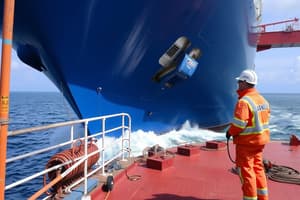Podcast
Questions and Answers
Considering the historical context of Abu Dhabi's oil agreements, what was the primary initial financial obligation of foreign oil companies operating in the region prior to ADNOC's establishment?
Considering the historical context of Abu Dhabi's oil agreements, what was the primary initial financial obligation of foreign oil companies operating in the region prior to ADNOC's establishment?
- Provision of advanced technological training and educational programs for Emirati nationals in petroleum engineering.
- Direct profit sharing based on net revenue, adjusted quarterly according to global market indices.
- Payment of taxes and royalties on the oil extracted, as stipulated by the governing agreements of the time. (correct)
- Obligatory reinvestment of a percentage of profits into local infrastructure development projects, as mandated by the ruling Sheikh.
Evaluate the strategic implications of Sheikh Zayed establishing the Abu Dhabi Investment Authority (ADIA) in 1976 within the broader context of Abu Dhabi's economic development. Which of the following best characterizes its long-term impact?
Evaluate the strategic implications of Sheikh Zayed establishing the Abu Dhabi Investment Authority (ADIA) in 1976 within the broader context of Abu Dhabi's economic development. Which of the following best characterizes its long-term impact?
- ADIA focused exclusively on funding the expansion of ADNOC's operations and enhancing its technological capabilities in oil exploration and production.
- ADIA facilitated diversification of the economy away from total reliance on oil revenues by strategically reinvesting funds into various sectors within the Emirate. (correct)
- ADIA served primarily as a vehicle for short-term speculative investments in international markets to generate immediate returns for the ruling family.
- ADIA's main goal was centralizing financial control, diminishing the influence of foreign entities in Abu Dhabi's economic landscape.
In the early agreements concerning Abu Dhabi's oil resources, a specific delineation of ownership was established between the government and foreign oil companies regarding oil and gas. What was this distinction?
In the early agreements concerning Abu Dhabi's oil resources, a specific delineation of ownership was established between the government and foreign oil companies regarding oil and gas. What was this distinction?
- The government retained ownership of both oil and gas reserves, while foreign companies were granted exclusive rights to exploration and extraction for a defined period.
- Ownership was structured as a joint venture, with the government holding a majority share in oil assets and foreign companies controlling gas distribution networks.
- Foreign oil companies possessed complete ownership of oil and gas discovered within their designated concession areas, subject to annual audits and compliance reports.
- The government maintained ownership of the gas, whereas foreign oil companies held ownership rights over the oil resources. (correct)
Analyze the potential geopolitical ramifications of ADNOC's current production capacity of approximately three million barrels of oil per day, situating it as the twelfth largest oil producer globally. Which scenario aligns most closely with established geopolitical theories?
Analyze the potential geopolitical ramifications of ADNOC's current production capacity of approximately three million barrels of oil per day, situating it as the twelfth largest oil producer globally. Which scenario aligns most closely with established geopolitical theories?
How did the establishment of ADNOC in 1971 strategically reposition Abu Dhabi's control over its oil industry, considering the existing agreements with foreign oil companies and the evolving global energy landscape?
How did the establishment of ADNOC in 1971 strategically reposition Abu Dhabi's control over its oil industry, considering the existing agreements with foreign oil companies and the evolving global energy landscape?
What innovative fiscal strategy did Sheikh Zayed implement in 1976 to ensure sustainable economic development for Abu Dhabi beyond immediate oil revenues, considering the long-term volatility of global commodity markets?
What innovative fiscal strategy did Sheikh Zayed implement in 1976 to ensure sustainable economic development for Abu Dhabi beyond immediate oil revenues, considering the long-term volatility of global commodity markets?
Considering the evolution of ADNOC's ownership stake in Abu Dhabi's oil resources from 1973 to 1974, what broader geopolitical and economic factors likely influenced this shift in equity?
Considering the evolution of ADNOC's ownership stake in Abu Dhabi's oil resources from 1973 to 1974, what broader geopolitical and economic factors likely influenced this shift in equity?
Analyze the long-term socio-economic impact of infrastructure development, spearheaded by oil and gas revenues, on the United Arab Emirates' societal structure and human capital, particularly concerning education and healthcare sectors.
Analyze the long-term socio-economic impact of infrastructure development, spearheaded by oil and gas revenues, on the United Arab Emirates' societal structure and human capital, particularly concerning education and healthcare sectors.
Flashcards
Murban-3
Murban-3
First oil well in Abu Dhabi, completed in May 1960.
ADNOC
ADNOC
Abu Dhabi National Oil Company, created in 1971 by Sheikh Zayed.
Early Oil Agreements
Early Oil Agreements
Originally, all gas belonged to the government; foreign companies owned the oil.
25% Share in Oil
25% Share in Oil
Signup and view all the flashcards
60% Share in Oil
60% Share in Oil
Signup and view all the flashcards
ADNOC Production
ADNOC Production
Signup and view all the flashcards
ADIA's Aim
ADIA's Aim
Signup and view all the flashcards
UAE University
UAE University
Signup and view all the flashcards
Study Notes
- The first oil well, Murban-3, was completed in May 1960.
- Murban-3 produced crude oil at a rate of 3,674 barrels per day.
- Following the completion of Murban-3, more oil fields were discovered rapidly.
- After the discovery of more oil fields, revenue from oil production began to increase dramatically.
- Sheikh Zayed created ADNOC, the Abu Dhabi National Oil Company, in 1971.
- ADNOC was created to hold the government’s share in the country’s oil industry.
- Earlier agreements stated that all gas resources belonged to the government.
- Foreign oil companies owned the oil and were required to pay taxes and royalties.
- In 1973, ADNOC acquired a 25% share in the oil.
- By 1974, ADNOC's share in the oil industry had increased to 60%.
- ADNOC currently manages and oversees the production of approximately three million barrels of oil per day.
- ADNOC is the twelfth largest oil producer in the world.
- Funding from the oil and gas industry enabled the government to implement significant infrastructure improvements through socio-economic construction.
- Sheikh Zayed established the Abu Dhabi Investment Authority (ADIA) in 1976.
- ADIA's purpose was to reinvest funds into the Emirate to foster growth.
- Hospitals, schools, and roads were built, greatly improving the quality of life.
- These improvements enhanced positive aspects of the UAE’s future.
- The United Arab Emirates University, the country’s first university, opened in Al Ain in 1977.
Studying That Suits You
Use AI to generate personalized quizzes and flashcards to suit your learning preferences.




